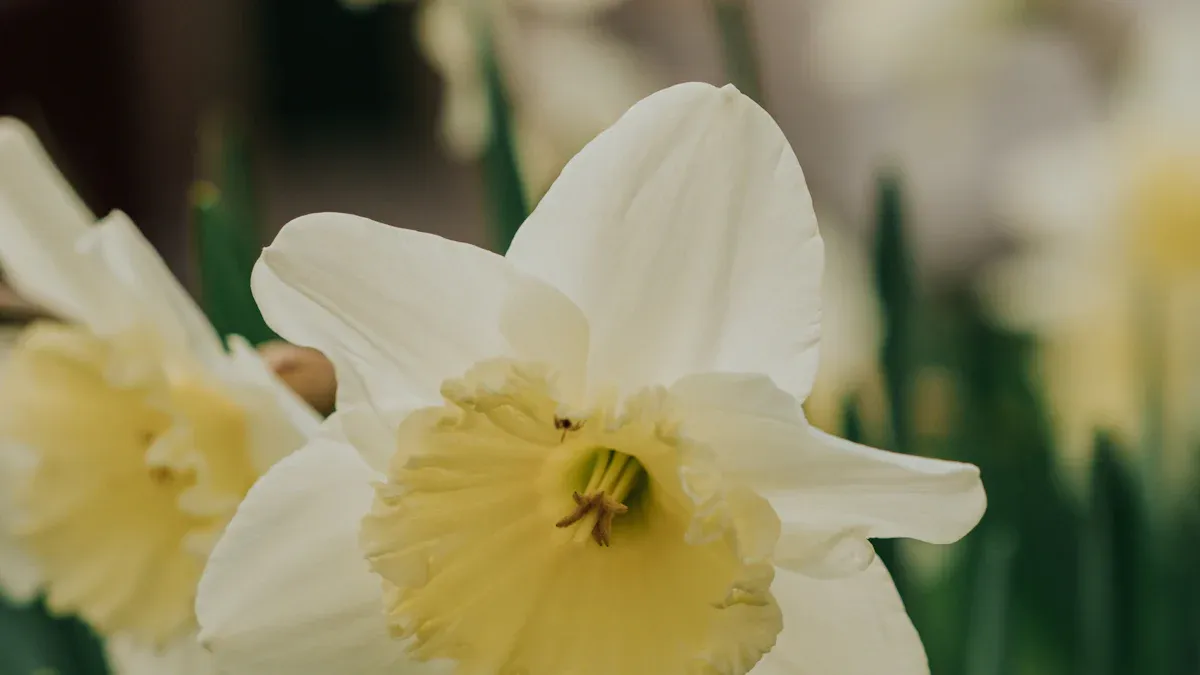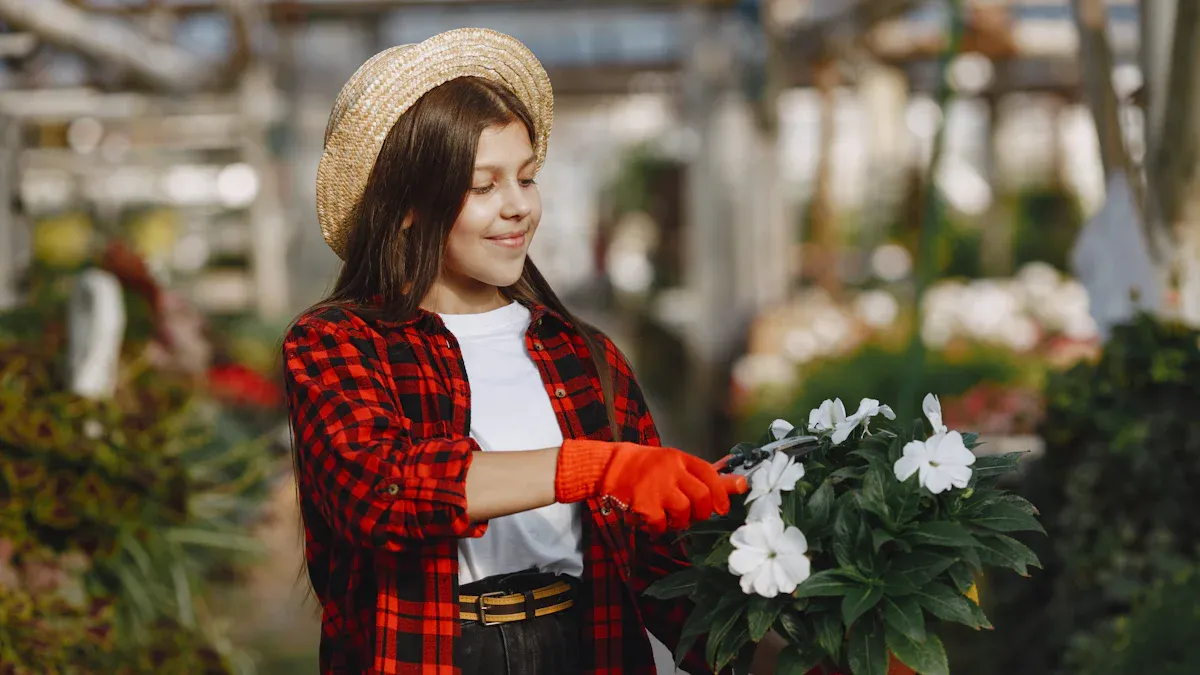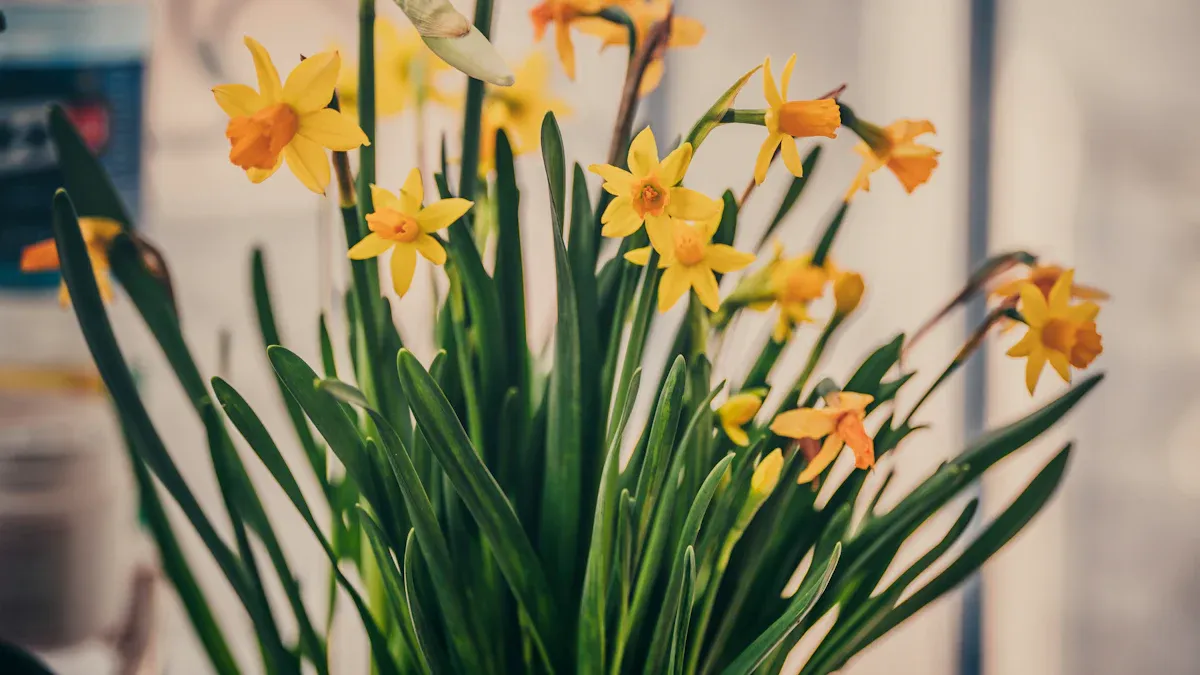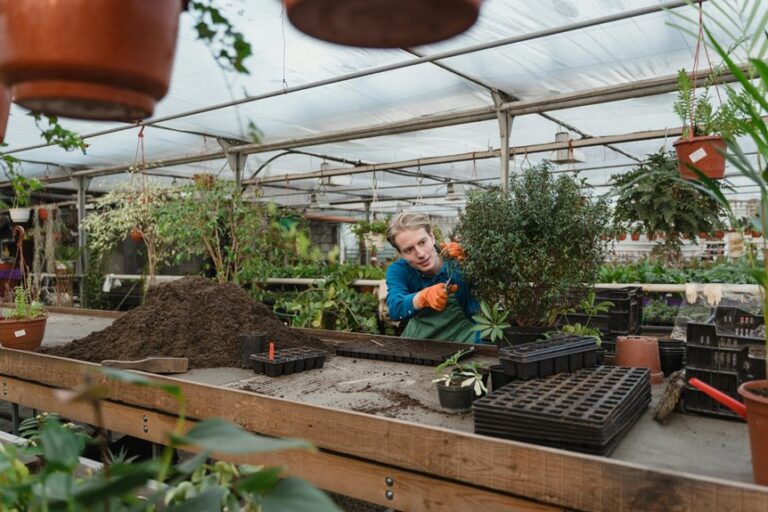
Taking care of your daffodils after they bloom is crucial for their health and vitality. Many gardeners worry about foliage management, cutting back too soon, and dealing with dead leaves. These issues can affect next year’s blooms. If you’re wondering what to do to keep your daffodils thriving, follow these key steps!
Concern | Explanation |
|---|---|
Foliage Management | Leaves must remain until they yellow to ensure food production for next year’s bulbs. |
Cutting Back Too Soon | Early cutting can prevent blooming the following year, as it impacts nutrient storage. |
Dead Foliage | Inhibits the plant’s ability to absorb sunlight, affecting nutrient storage for future blooms. |
Key Takeaways
Allow daffodil foliage to die back naturally for at least six weeks after blooming. This process helps the bulbs store energy for next year’s growth.
Deadhead spent flowers promptly to redirect the plant’s energy back into the bulb instead of seed production. This promotes healthier blooms in the following season.
Water your daffodils regularly, keeping the soil moist but not soggy. Proper watering supports nutrient absorption and overall plant health.
What to Do After Blooming
Deadheading Daffodils
After your daffodils bloom, one of the first things you should consider is deadheading. This process involves removing the spent flowers to prevent the plant from wasting energy on seed production. By deadheading, you encourage the plant to focus on what really matters: storing energy for next year’s blooms.
Tip: Deadheading not only keeps your garden looking tidy, but it also promotes healthier bulbs. When you remove the faded flowers, you help the plant redirect its energy back into the bulb instead of producing seeds.
Immediate deadheading can hinder the plant’s ability to photosynthesize effectively. This process is essential for energy storage in the bulb. If you wait too long, the plant may struggle to gather the energy it needs for next year’s growth. Delayed deadheading allows the leaves to continue photosynthesis, which is crucial for accumulating necessary energy reserves.
Timing for Deadheading
Timing is everything when it comes to deadheading daffodils. Here are some key points to keep in mind:
Deadhead daffodils as the flowers fade.
Wait at least six weeks after flowering before removing the leaves.
Allow foliage to photosynthesize for energy storage.
After you deadhead, don’t cut back the leaves for at least six weeks. The leaves are essential for photosynthesis, which supports next year’s blooms. Allowing the foliage to die back naturally improves next year’s display. Typically, the leaves will turn brown and die back four to six weeks after flowering.
Factor | Description |
|---|---|
Light Requirements | Daffodils thrive in bright, indirect sunlight, which is essential for robust flower development. |
Nutritional Needs | Key nutrients like phosphorus and potassium are vital for root and flower development. |
Pruning Techniques | Proper pruning, including deadheading and timing, encourages new growth and enhances flowering. |
By following these steps, you can ensure that your daffodils remain healthy and vibrant for the next blooming season. Remember, proper care after blooming is just as important as the care you provide during their growth.
Cutting Foliage

After your daffodils bloom, cutting back the foliage is an important step in their care. However, timing and technique matter greatly. Let’s dive into when and how to cut back your daffodil leaves to ensure they thrive for the next blooming season.
When to Cut Back
You should wait until the foliage has completely turned brown and died back before cutting it. This usually happens in late June or early July. Allowing the leaves to remain for this period is crucial because:
Daffodil leaves need 8-10 weeks post-bloom to produce food for the next year’s growth.
Cutting the leaves too early interrupts this process, leading to fewer flowers in the next bloom cycle.
Healthy bulbs rely on this energy to develop roots, shoots, and flowers.
The plant uses the dying leaves to gather energy for about four to six weeks after blooming. If you cut back too soon, you deprive the bulbs of the energy they need for growth and flowering.
Tip: Always let the foliage die back naturally. This practice not only supports the plant’s health but also enhances the beauty of your garden as the leaves transition through their natural lifecycle.
How to Cut Back Properly
When it’s time to cut back the foliage, follow these best practices to maximize bulb health:
Wait until the leaves have turned brown and died back completely.
Avoid tying or braiding the leaves. This ensures maximum leaf area is exposed to sunlight for food production.
Use clean, sharp garden shears to make a clean cut at the base of the leaves.
Premature removal of foliage can reduce plant vigor and bulb size, leading to fewer flowers in the following spring. Remember, the leaves are essential for photosynthesis, which allows the bulb to store energy. Without this energy, the bulb cannot sustain itself through winter or produce strong flowers in the next blooming season.
By following these guidelines, you can ensure that your daffodils remain healthy and vibrant. Proper care after blooming is just as important as the care you provide during their growth.
Watering and Fertilization
Watering Needs
After your daffodils bloom, proper watering is essential for their health. Here are some key points to keep in mind:
Keep the soil moist while the plants are growing, typically from fall through May or June.
Water the withering plant in dry conditions. This helps the bulbs gather nutrients for the next season.
Avoid overwatering, as it can lead to root rot, which negatively impacts the plant’s ability to thrive.
Underwatering can stress the plant, causing buds to drop and resulting in fewer blooms.
By following these watering guidelines, you can ensure your daffodils have the moisture they need to store energy for next year.
Fertilization Tips
Fertilizing your daffodils is just as important as watering. Here are some tips to help you nourish your bulbs effectively:
Fertilize early in the spring when the first leaf tips emerge. Use granular fertilizers made for bulbs or a general-purpose 5-10-5 fertilizer.
Apply fertilizer by scattering it among the emerging leaves and lightly scratching it into the soil.
Consider deadheading the flowers after blooming to redirect energy back into the bulb.
Leave the foliage in place until it turns yellow to allow the bulb to store energy.
As daffodil bulbs age, the surrounding soil quality declines. Adding organic amendments like compost or mulch post-bloom can rejuvenate the soil and support healthy growth. Some experts recommend fertilizing again 6-8 weeks after blooming to prepare for next year’s growth.
By following these watering and fertilization tips, you can help your daffodils thrive and ensure a vibrant display in the following season.
Preventing Daffodil Blindness

Understanding Daffodil Blindness
Daffodil blindness is a frustrating condition where your daffodils produce healthy green leaves but fail to bloom. This issue can affect not just daffodils but also other bulbous plants. You might notice lush foliage in your garden, but without flowers, it can feel like something is missing. Understanding the causes of this condition can help you take steps to prevent it.
Cause | Description |
|---|---|
Environmental Conditions | Daffodils may die prematurely due to drought or dry weather, preventing energy storage after flowering. |
Gardener Error | Mistakes like planting bulbs too late or mowing foliage too soon can hinder flowering. |
Pests & Diseases | Damage from pests like narcissus eelworm and narcissus bulb fly can lead to poor flowering or blindness. |
Steps to Prevent It
Preventing daffodil blindness is easier than you might think! Here are some effective steps you can take:
Select good quality bulbs that feel firm to the touch.
If planting in turf, choose cultivars like ‘Peeping Tom’ or ‘February Gold’ that are suitable for naturalizing.
Plant bulbs from mid-August to October.
Choose an open sunny spot for planting and avoid very dry areas.
Prepare the soil well by forking in homemade compost if it’s poor.
Plant bulbs at a depth of two to three times their size.
Deadhead flowers as they fade to redirect energy back to the bulb.
Don’t tidy up the foliage; let them die down naturally.
After flowering, wait at least six weeks before removing or mowing the leaves.
Improve dry soil by mulching around the bulbs with homemade compost in late winter.
By following these steps, you can help ensure your daffodils bloom beautifully year after year. Remember, a little care goes a long way in keeping your garden vibrant! 🌼
Relocating Daffodils
Relocating daffodils can be a great way to refresh your garden or improve their growing conditions. Here are some best practices to follow when you decide to move your daffodils.
How to Relocate
Wait for the foliage to die back naturally: After blooming, let the green leaves remain. They’re essential for feeding the bulb for next year’s flowers.
Choose a dry day: Make sure the soil is dry to avoid damaging the bulbs while digging.
Dig carefully: Plan to dig them up around early to mid-June, when the foliage has turned yellow and flopped over. Use a garden fork or spade to gently lift the bulbs without harming them.
Dry and store (if not replanting immediately): Let the bulbs dry for a day or two in a cool, shady place. Store them in a paper or mesh bag in a cool, dry spot. If you’re moving them to a new spot right away, you can replant them immediately.
Replant at the same depth: When you replant, make sure to place them at the same depth they were before. Water them in to help reduce transplant shock.
Tip: Expect reduced blooms next year after relocating, but don’t worry! They should bounce back over time.
Timing for Relocation
Timing is crucial when relocating daffodils. The best time to transplant them varies by climate. In mild winter areas, late November to early December works well. In regions with early frosts, aim for late September to early October. After flowering, wait until the leaves begin to die back but are not completely gone. This way, you’ll know exactly where to dig.
If you’re relocating underperforming plants, do so after blooming when the leaves start to die back. You can even move them while they’re still green, but this might affect next year’s blooms. Remember, cutting back the foliage too early can prevent the plant from generating the energy needed for the bulb’s health and future blooms.
By following these guidelines, you can successfully relocate your daffodils and enjoy their beauty for years to come! 🌼
Taking care of your daffodils after they bloom is vital for their health. Remember to:
Allow foliage to die back naturally for energy storage.
Water adequately and avoid overcrowding.
Deadhead flowers to redirect energy.
By following these tips, you’ll enjoy vibrant blooms next season! 🌼
FAQ
What should I do if my daffodils don’t bloom next year?
If your daffodils don’t bloom, check for proper sunlight, watering, and nutrient levels. Also, ensure you didn’t cut the foliage too early.
How often should I water my daffodils after blooming?
Water your daffodils regularly, especially during dry spells. Keep the soil moist but avoid overwatering to prevent root rot.
Can I fertilize my daffodils after they bloom?
Yes! Fertilize your daffodils after blooming to help them store energy for next year. Use a balanced fertilizer for best results. 🌼


